|
SMALL
TELESCOPES
& ASTRONOMICAL
RESEARCH
STAR Conference on smaller
telescopes (two meters or less)
Their development and use in research and education
June 19-22, 2008
Embassy Suites, San Luis Obispo, California Introduction
to Small Telescopes and Astronomical Research
(click here for the STAR Conference Summary)
|
Affordable CCD cameras, compact go-to telescopes, and powerful personal
computers (not to mention DSLR and video cameras) have transformed small
telescopes into powerful tools for astronomical research. “Dobsonian”
mirrors up to one-meter aperture and affordable control systems are
being combined into highly capable equatorial and alt-az telescopes.
These larger telescopes not only allow precise astrometric and
photometric observations of faint objects but, with recently available
spectrographs, both time-series and classification spectroscopy are now
affordable. Robotic and remote access small telescopes are facilitating
observations both locally and remotely around the globe. High school and
undergraduate students are joining the ranks of amateur and professional
astronomers in utilizing small telescopes for astronomical research.
Whether conducting astronomical research or developing new telescopes or
software, students gain invaluable hands-on experience in science and
engineering while, as coauthors of published papers, their careers are
given a boost. |
|
Small telescopes
and CCD Cameras have revolutionized
small telescope astronomy. The three Cuesta College students shown here used the 10-inch
telescope and SBIG CCD Camera at the Orion Observatory
during a 2006 Cuesta College research
seminar to discover
two new variable stars. |
|
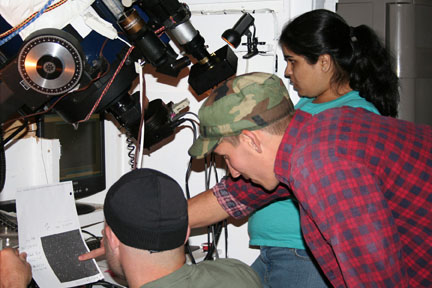
Noll Roberts, Casey Milne, and
Neelie Jaggi
use a small telescope
and CCD camera to observe a variable star. |
Scientific Research
|
Research projects suitable for small telescopes include: measuring photometric variations over time of
asteroids, intrinsically variable stars, cataclysmic variables, eclipsing
binaries, exoplanet transits, and microlensing events; astrometry of visual
double stars, asteroids and comets; searching for asteroids, comets, nova,
and supernova; occultation timing; and, with the larger of
the small telescopes, obtaining spectroscopic time-series and assigning spectral classifications. |
|
The light curve
of transiting exoplanet Wasp 1b observed by Jim Carlisle and, remotely, by
Cindy Foote and Tom Smith as part of the Cuesta College 2007 research
seminar. The transit occurred 29.1 minutes later than predicted. |
|

Foote's Exoplanet Light Curve (Wasp
1b)
|
|
Cataclysmic variable stars are exciting to study. Matter is pulled from a red giant into an
accre-tion disk around a white dwarf. Eventually clumps of matter fall
onto the white dwarf, creating a visible explosion of heat and light.
The Center for Backyard Astrophysics (CBA) coordinates photo-metric observations
around the globe |
|
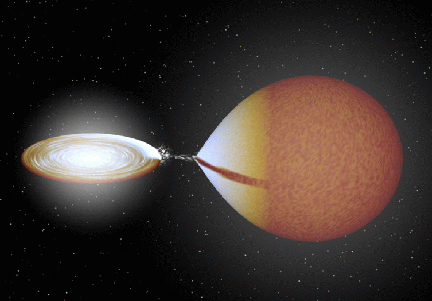
Cataclysmic variable stars
|
Technological Development
|
New CCD cameras, spectrographs, and software for smaller telescopes are being developed. A
number of new German equatorial mounts and superb wide-field OTAs,
driven largely by astrophotography demands, are also benefiting
scientific research. Affordable, high-quality 32-inch mirrors are now
readily available, as are low-cost, highly capable control systems. A
new breed of affordable equatorial and alt-az telescopes, now
approaching 1-meter aperture, is
being designed by students, amateurs, and commercial manufacturers. With
the advent of advanced software, remote access robotic observatories
have become commonplace. The engineering and software development of
these high-tech instruments, telescopes, and observatories are
challenging the creativity of a wide range of students, amateurs, and
manufacturers. |
|
Russ Genet, Richard Berry, Howard Banich,
Dave Rowe, Mel
Bartels, Dan Gray, Ed Harvey, and Greg Jones pose by Dan’s 14-inch alt-az telescope, which is a
test bed for new alt-az telescope control systems. |
|
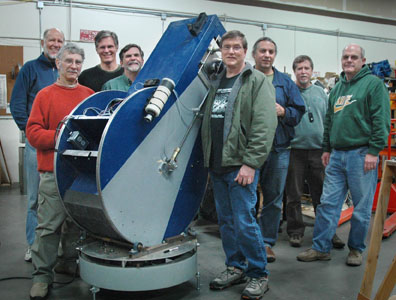
Dan Gray's 14 inch alt-az telescope
|
|
Astrophotography is a demanding
art. The sophisticated image processing techniques required to produce
such exquisite images drive small telescope technology to the benefit
of science. This image of the Horsehead Nebula was taken by Robin White
on his 10-inch Meade LX200 telescope with a StarlightXpress CCD camera. |
|
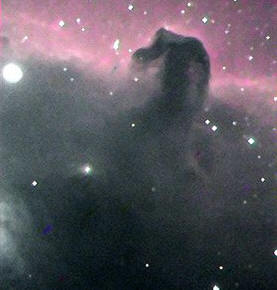
The Horsehead Nebula
|
|
Howard Banich and
Russ Genet stand beside Howard’s portable 28-inch alt-az
telescope. Such portable telescopes can be used for faint-object
scientific observations. |
|
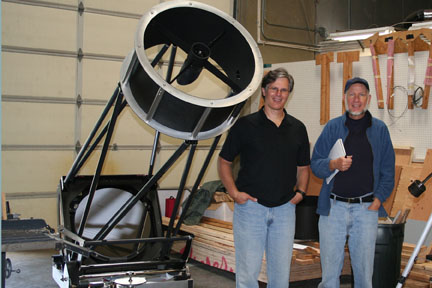
Howard Banich's 28-inch alt-az
telescope
|
Education through Research
|
Small telescope astronomical research is particularly well suited to high school
and undergraduate students. The telescopes and instruments are affordable and
can be used to conduct useful research in many areas. In one- or two-semester
research courses and summer camps, students have proven their ability to conduct
high-quality, published research. Through such hands-on research, these students
develop an appreciation for the true exploratory nature of science. Their
published papers also
shift their educational careers into high gear. Whether by designing and
developing telescopes and robotic observatories, making astronomical
observations, or analyzing data and writing papers, students hone their skills
as they engage their school with cutting-edge scientific research. |
|
Darrell Grisham, an
amateur astronomer and member of the
Cuesta College Fall 2007 physics research seminar, has proven beyond a shadow of a
doubt that even very small vintage telescopes can still do real science. His observations
of visual double stars with a 3-inch, 1960’s vintage Tasco telescope
were almost twice as precise as what are generally considered
good visual astrometric measurements. His observations have been
published in the Journal of Double Star Observations.
See www.jdso.org |
|
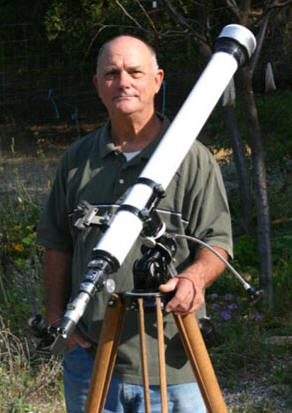
Darrell Grisham and his vintage Tasco
|
|
Tom Frey, Professor of Chemistry and a member of
the Cuesta College research seminar, is hiding behind his 18-inch
Obsession telescope. He observed neglected double stars and developed a new
astrometric
measurement technique for alt-az telescopes. |
|

Tom Frey and his 18-inch Obsession
|
|
The Cuesta College research seminar has a wide
cross section of high school, undergraduate, and retired students—as well
as several PhD’s—working cooperatively to conduct and submit original research
for publication. Jo
Johnson, left, and Jim Carlisle, right, are reducing time series
photometric data of
exoplanet Wasp 1b. |
|
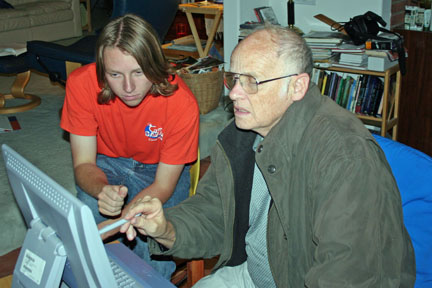
Jo Johnson and Jim Carlisle
|
STAR Conference
Summary
|
The STAR conference is being co-chaired by Russ Genet, a Research
Scholar in Residence at California Polytechnic State University and
Adjunct Professor of Astronomy at Cuesta College, and Jo Johnson, a
student at Cuesta College. As a member of Russ’ recently
completed fall
research seminar, Jo has six research papers to his credit and brings a
vital student perspective to the conference. We are placing special
emphasis on attracting high school and undergraduate students to the
STAR Conference, and have established a travel/conference expense fund, administered
by the Dark Ridge observatory, to facilitate their participation.
Donations would be greatly appreciate. To learn more about this
fund and to make a donation click here.
The STAR Conference has been organized to accommodate a
wide range of attendees, from high school students with an interest in
science but little knowledge of scientific research, astronomy, or
telescopes, to seasoned amateur and professional researchers with
decades of observational and scientific or engineering experience.
An optional six hour tutorial on Thursday will provide
students and other neophytes to astronomical research and development,
with sufficient background to understand the rest of the
conference.
The remainder of the conference, Friday, Saturday, and
Sunday, will feature three different types of sessions. Plenary
sessions, the first thing each of these three mornings, will each provide
six twenty-minute topical overviews. These overviews, 18 in all
across the three days, will
introduce all attendees to the topics that will be
covered in greater depth in the parallel special focus sessions which
will occupy the remainder of the mornings and afternoons (except for
Saturday afternoon, which will be devoted to a bus excursion and tour of
Hearst Castle).
Each special focus session will explore a single
topic in greater depth with four 20-minute talks followed by a 40 minute
panel with short summaries, discussions, and questions submitted in
writing from the
audience. There are, all told, 15 STAR Conference special focus
sessions. They are scheduled three at a time. Thus attendees can choose
five of the 15 sessions to suit
their specialized interests.
Finally, evening plenary sessions will provide
presentations of general interest, including student presentations on
Friday evening. |
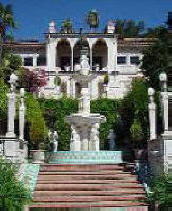
Hearst Castle |

Assembly Room |
|
Saturday
afternoon will begin with a box lunch during a bus trip up
the scenic coast to the historic Hearst Castle overlooking the
small town of San Simeon. The tour will include an IMAX movie on the building of the Hearst Castle
at the Hearst visitors center. The bus will depart for
Embassy Suites at 5:30 and the evening will be free to visit and enjoy San Luis
Obispo. |
|
|
Commercially manufactured equipment and other
displays are welcome for the duration of the conference, and there will be boards
for displaying posters in the foyer. Written papers are not mandatory, but are
encouraged. The conference proceedings will be published as a book by
the Collins Foundation Press.
On Friday evening, the STAR Conference 2008 Student Research and Development
awards will be announced and selected
recipients will give short talks that will describe their research or development project
to the general audience. |
|
The Embassy Suites features a beautiful atrium for
breakfast, lunch, and dinner. Guests enjoy the comfort of luxurious
two-room suites. |
|
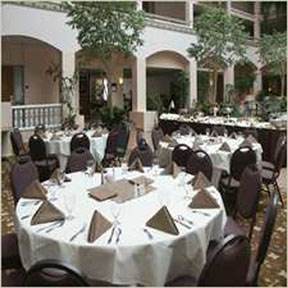
The Embassy Suites' Atrium
|
Back to the Top |